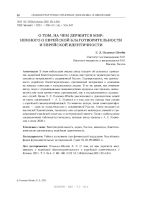О том, на чем держится мир: немного о еврейской благотворительности и еврейской идентичности
Translated Title
The World Wags on It: About Jewish Philanthropy and Jewish Identity
Author(s)
Publication Name
Publication Date
Abstract
В этом небольшом очерке автор говорит об основных принципах еврейской благотворительности, а также дает краткую характеристику ее основных направлений в современной России. Подчеркивается, что деятельность еврейских благотворительных организаций направлена в основном на помощь пожилым и нуждающимся людям. В то же время, как отмечает автор, люди с ограниченными возможностями здоровья, как правило, оказываются вне поля зрения таких организаций, как и государственных социальных служб. Далее Е. Э. Носенко-Штейн рассказывает о руководителе одной из таких организаций — А. Е. Кирносе и о том, как его приход туда связан с еврейской самоидентификацией. По мнению автора, такая самоидентификация — одна из существующих в современной России. Автор называет ее
носителей Хранителями, поскольку они сохраняют некоторые элементы традиционной еврейской культуры и исторической памяти. Ниже с небольшими сокращениями публикуется интервью, которое автор провела с А. Е. Кирносом в июле 2020 г.
носителей Хранителями, поскольку они сохраняют некоторые элементы традиционной еврейской культуры и исторической памяти. Ниже с небольшими сокращениями публикуется интервью, которое автор провела с А. Е. Кирносом в июле 2020 г.
Translated Abstract
In this essay, the author briefly describes main principles of Jewish philanthropy and its main trends in Russia. Elena E. Nosenko-Stein stresses that activities of Jewish philanthropic organizations mainly cover needs of aged and
poor persons. At the same time, the author notes that disabled persons, as a rule, do not become the recipients of Jewish both philanthropic organizations and Russian social services. Further the author tells about the Head of one of such organizations, Aleksander Ye. Kirnos and his Jewish self-identification as an impulse of his coming to Jewish philanthropic activities. Elena E. Nosenko-Stein underlines that his self-identification is one of the forms of Jewish self-identifications existing in contemporary Russia. Drawing on her research of Jewish identities, Elena E. Nosenko-Stein names people with this self-identification Guardians as they save and guard some elements of traditional Jewish (East Ashkenazic) culture and memory. Below is the text of the interview with Aleksander Kirnos (conducted by Elena E. Nosenko-Stein in July 2020)
poor persons. At the same time, the author notes that disabled persons, as a rule, do not become the recipients of Jewish both philanthropic organizations and Russian social services. Further the author tells about the Head of one of such organizations, Aleksander Ye. Kirnos and his Jewish self-identification as an impulse of his coming to Jewish philanthropic activities. Elena E. Nosenko-Stein underlines that his self-identification is one of the forms of Jewish self-identifications existing in contemporary Russia. Drawing on her research of Jewish identities, Elena E. Nosenko-Stein names people with this self-identification Guardians as they save and guard some elements of traditional Jewish (East Ashkenazic) culture and memory. Below is the text of the interview with Aleksander Kirnos (conducted by Elena E. Nosenko-Stein in July 2020)
Topics
Fundraising and Philanthropy Charity / Tzedakah Jewish Identity Jewish Organisations Main Topic: Other
Genre
Geographic Coverage
Original Language
Volume/Issue
2(4)
Page Number / Article Number
80-100
DOI
Link
Link to article including link to pdf, О том, на чем держится мир: немного о еврейской благотворительности и еврейской идентичности
Bibliographic Information
О том, на чем держится мир: немного о еврейской благотворительности и еврейской идентичности. 2021: 80-100. https://archive.jpr.org.uk/10.15826/koinon.2021.02.4.041




